Sparta, Greece, Tuesday morning, 3 April 2001
Et in Arcadia ego (Even in Arcadia am I), as Death is quoted on a tomb in an old painting. Actually we are in Laconia now. (Little or nothing remains to see of the city of Menelaos, Tyrtaeus, or Leonidas, so we are here in Sparta mainly just for a convenient overnight stop.) But yesterday we did pass through Arcadia, and lunched in its rather dreary capital, Trípoli. Arcadia in fact, though beautiful in two contrasting ways (desolate mountains enclosing a fertile plain), has little to do with the perennial Arcadia of imagination, the classic and standard setting for pastoral idyll; and the herders we saw in the mountains (more of goat than of sheep) bore very little resemblance to either Dresden china or to the character Strephon in Gilbert and Sullivan's Iolanthe. And anyhow, today's journal has rather to do with our morning yesterday in the Argolid.

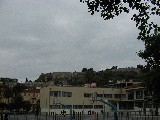 Before we set out for Epidaurus, I took these photos of the Frankish castle that occupies the impossibly steep hill looming above Náfplio and its harbor, and spills over onto a lower hill to the right. As you can see, our weather still has not improved all that much.
Before we set out for Epidaurus, I took these photos of the Frankish castle that occupies the impossibly steep hill looming above Náfplio and its harbor, and spills over onto a lower hill to the right. As you can see, our weather still has not improved all that much.
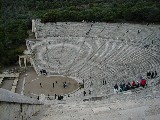 At the theater of Epidaurus, much the best preserved of classical Greek theaters and still in use for summer festivals, British girls from a tour group took turns singing to test the celebrated acoustics of the place (and some silly lads with garish plastic toys staged a mock sword fight, which would never have been done in an ancient Greek play, and seemed like a pollution). I meanwhile tried reckoning angles and counting stones, to see if they were consistent with a certain German scholar's theory that a pentagram was inscribed in the circle of the orchestra, with staircases arising at four of its points and the fifth pointing upstage center. It does appear to work out if you take every fourth staircase, including the two at the foremost edges of the cavea. The pentagram is a Pythagorean symbol for health, according to Lucian. This might be because the figure multiply embodies the golden proportion, by which the longer of two lengths is the geometric mean between the shorter one and the sum of them both. (That is, a + b =c and a:b::b:c. The ratio a:b works out to 0.6180339..., the precise calculation involving taking the square root of five, subtracting one, and then dividing by two. All the linear magnitudes that are defined in the figure of the pentagram form a series in which the ratio of each to the next greater is this same "golden" proportion.) As it is defined in terms of a geometric mean, so the golden proportion in turn implicitly suggests the golden mean, though so far as I know neither bore that epithet "golden" at the time in question; and ancient physicians as well as philosophers, and modern physicians as well, praise the mean or moderate course. Was drama conceived by the ancients as a healing ritual, to be assisted by building a kind of talisman or charm into the very fabric of the theater? According to the building accounts, which were preserved, being literally carved in stone, this theater was built as part and parcel of Greece's leading sanctuary for the worship of Asclepius, the healer. The sick would come to Epidaurus to sleep in the "abaton," and be healed by the god in their dreams, with results that persisted on waking--after which they would owe the god the sacrifice of a cock, and/or a sort of sculptured votive offering, often depiciting the body part that had been healed and thus advertising the efficacy of the therapy.
At the theater of Epidaurus, much the best preserved of classical Greek theaters and still in use for summer festivals, British girls from a tour group took turns singing to test the celebrated acoustics of the place (and some silly lads with garish plastic toys staged a mock sword fight, which would never have been done in an ancient Greek play, and seemed like a pollution). I meanwhile tried reckoning angles and counting stones, to see if they were consistent with a certain German scholar's theory that a pentagram was inscribed in the circle of the orchestra, with staircases arising at four of its points and the fifth pointing upstage center. It does appear to work out if you take every fourth staircase, including the two at the foremost edges of the cavea. The pentagram is a Pythagorean symbol for health, according to Lucian. This might be because the figure multiply embodies the golden proportion, by which the longer of two lengths is the geometric mean between the shorter one and the sum of them both. (That is, a + b =c and a:b::b:c. The ratio a:b works out to 0.6180339..., the precise calculation involving taking the square root of five, subtracting one, and then dividing by two. All the linear magnitudes that are defined in the figure of the pentagram form a series in which the ratio of each to the next greater is this same "golden" proportion.) As it is defined in terms of a geometric mean, so the golden proportion in turn implicitly suggests the golden mean, though so far as I know neither bore that epithet "golden" at the time in question; and ancient physicians as well as philosophers, and modern physicians as well, praise the mean or moderate course. Was drama conceived by the ancients as a healing ritual, to be assisted by building a kind of talisman or charm into the very fabric of the theater? According to the building accounts, which were preserved, being literally carved in stone, this theater was built as part and parcel of Greece's leading sanctuary for the worship of Asclepius, the healer. The sick would come to Epidaurus to sleep in the "abaton," and be healed by the god in their dreams, with results that persisted on waking--after which they would owe the god the sacrifice of a cock, and/or a sort of sculptured votive offering, often depiciting the body part that had been healed and thus advertising the efficacy of the therapy.
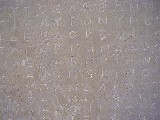 Verbal testimony to cures was also carved in stone, and makes for very interesting reading.
Verbal testimony to cures was also carved in stone, and makes for very interesting reading.

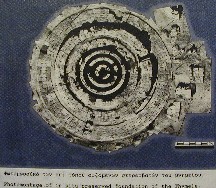 The exquisite capital at left was apparently Polyclitus' prototype for the Corinthian interior colonnade of the tholos or round temple in the sanctuary, dating from the fourth century B.C. and closely contemporary with the theater according to Pausanias' encyclopedic Description of Greece. This capital is so well preserved because it was apparently deliberately buried. The actual building, which like the altar formerly at the center of the theater's orchestra is called the "Thymele," is now in the throes of modern restoration, but it seems to have had a kind of maze (for the temple snake?) built into its foundation, and this is interpreted as a sign of the chthonic character of the Asclepius cult.
The exquisite capital at left was apparently Polyclitus' prototype for the Corinthian interior colonnade of the tholos or round temple in the sanctuary, dating from the fourth century B.C. and closely contemporary with the theater according to Pausanias' encyclopedic Description of Greece. This capital is so well preserved because it was apparently deliberately buried. The actual building, which like the altar formerly at the center of the theater's orchestra is called the "Thymele," is now in the throes of modern restoration, but it seems to have had a kind of maze (for the temple snake?) built into its foundation, and this is interpreted as a sign of the chthonic character of the Asclepius cult.
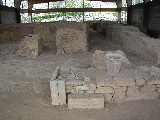
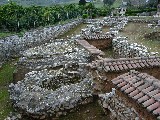 Our next stop was opposite Náfplio at the top of the Argolic Gulf, at Lerna. Our guidebook led us to expect to find the archaeological site closed on a Monday, but we found otherwise. Here in the 1950s archaeologists from the American School uncovered some remarkable finds from the Middle Neolithic and Early and Middle Helladic periods. The well-preserved foundations of a large house or small palace (approximately 300 square meters), the "House of the Tiles," are sheltered in a shed and date from approximately four and a half millennia ago. It was a two-storey building (at least), with thirteen rooms on the ground floor, and a tile roof, fragments from which pervaded the site (hence the name); but it was destroyed by fire while it was yet unfinished, some walls having been scored for plastering that never got done. At left you can see the main entrance (with restored wooden door-jamb). Of similar date is the fortification wall with enclosed compartments and tower, right.
Our next stop was opposite Náfplio at the top of the Argolic Gulf, at Lerna. Our guidebook led us to expect to find the archaeological site closed on a Monday, but we found otherwise. Here in the 1950s archaeologists from the American School uncovered some remarkable finds from the Middle Neolithic and Early and Middle Helladic periods. The well-preserved foundations of a large house or small palace (approximately 300 square meters), the "House of the Tiles," are sheltered in a shed and date from approximately four and a half millennia ago. It was a two-storey building (at least), with thirteen rooms on the ground floor, and a tile roof, fragments from which pervaded the site (hence the name); but it was destroyed by fire while it was yet unfinished, some walls having been scored for plastering that never got done. At left you can see the main entrance (with restored wooden door-jamb). Of similar date is the fortification wall with enclosed compartments and tower, right.
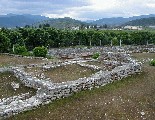
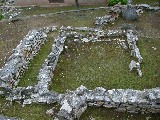
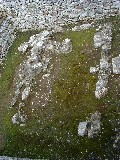 The house foundations at left are roughly four thousand years old; those at right, enclosed in a (modern) stone-walled rectangular well going down a couple of meters beneath the surrounding ground level, are roughly seven thousand years old--older than the pyramids, Stonehenge, or even Newgrange in Ireland. It is no such striking intact monument as they are, of course, but in a way a regular village house can speak to you more than a major monument or temple.
The house foundations at left are roughly four thousand years old; those at right, enclosed in a (modern) stone-walled rectangular well going down a couple of meters beneath the surrounding ground level, are roughly seven thousand years old--older than the pyramids, Stonehenge, or even Newgrange in Ireland. It is no such striking intact monument as they are, of course, but in a way a regular village house can speak to you more than a major monument or temple.
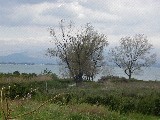 Here is a view from the site towards the Gulf, with some marshy shore. It was in the marshes of Lerna that Heracles found, fought, and slew the nine-headed serpent Hydra, except for one immortal head that he buried under a rock, where it presumably lives yet, with what baleful consciousness can only be imagined. Someone could make a good horror film, or a bad one, on the premise of somebody's digging it up.
Here is a view from the site towards the Gulf, with some marshy shore. It was in the marshes of Lerna that Heracles found, fought, and slew the nine-headed serpent Hydra, except for one immortal head that he buried under a rock, where it presumably lives yet, with what baleful consciousness can only be imagined. Someone could make a good horror film, or a bad one, on the premise of somebody's digging it up.
previous entry
next entry
main/ToC page

 Before we set out for Epidaurus, I took these photos of the Frankish castle that occupies the impossibly steep hill looming above Náfplio and its harbor, and spills over onto a lower hill to the right. As you can see, our weather still has not improved all that much.
Before we set out for Epidaurus, I took these photos of the Frankish castle that occupies the impossibly steep hill looming above Náfplio and its harbor, and spills over onto a lower hill to the right. As you can see, our weather still has not improved all that much.









